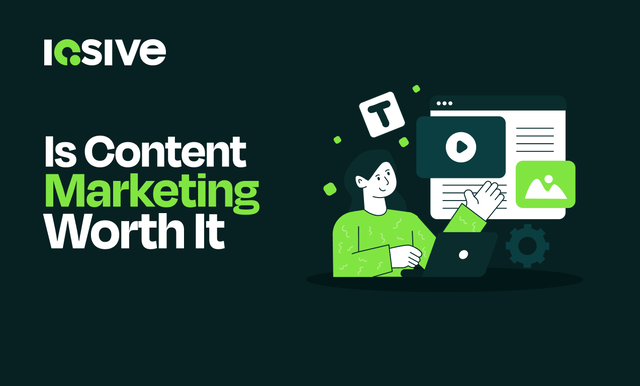Content marketing has become one of the most debated strategies in modern business. While some argue it’s the backbone of long-term growth, others question whether the investment pays off. This guide explores content marketing in depth, including its benefits, challenges, and measurable ROI, so you can decide if it’s truly worth it for your business.
Understanding the Value of Content Marketing
What Content Marketing Really Means
Content marketing is not just about publishing blogs or social media posts, it’s a strategic approach to creating and distributing valuable, relevant, and consistent content to attract and retain a clearly defined audience. Unlike traditional advertising, it doesn’t push products directly; instead, it educates, informs, and builds trust.
Why Businesses Invest in Content Marketing
Companies invest in content marketing because it aligns with how modern consumers research and make purchasing decisions. According to HubSpot, 82% of marketers actively use content marketing, largely because it generates three times more leads than traditional marketing at a fraction of the cost. Businesses see it as an opportunity to nurture customers across the buyer’s journey.
The Benefits of Content Marketing
Building Long-Term Brand Authority
Publishing high-quality, consistent content helps establish a business as an industry thought leader. Over time, audiences come to associate the brand with expertise and trustworthiness, which directly influences purchase decisions.
Driving Organic Traffic and SEO Growth
Search engines prioritize content-rich websites. Blogs, videos, and guides that address user questions improve search rankings, driving sustainable organic traffic. For example, companies like HubSpot built entire growth models around educational content that ranks for thousands of industry terms.
Generating Qualified Leads and Conversions
Content marketing attracts users who are actively searching for solutions. By offering resources like whitepapers, case studies, or tutorials, businesses can generate high-quality leads more effectively than with cold outreach.
Strengthening Customer Relationships and Trust
Content nurtures relationships long after the initial purchase. Newsletters, knowledge bases, and educational resources build loyalty by showing customers that the brand values their long-term success.
Content Marketing vs. Traditional Advertising
Cost-Effectiveness Over Time
Traditional advertising often requires continuous spending to maintain visibility, while content marketing compounds in value. A blog post published today can generate leads for years, unlike a paid ad that stops driving results once the budget ends.
Measuring ROI Differences
Paid ads deliver immediate but short-lived returns. Content marketing, on the other hand, requires patience but often delivers higher ROI over time. Demand Metric reports that content marketing costs 62% less than traditional marketing and generates about three times as many leads.
Audience Engagement Comparison
Advertising interrupts. Content marketing engages. Users actively seek out blogs, videos, or podcasts that answer their questions, making them more receptive to brand messaging compared to forced exposure in ads.
Challenges and Limitations of Content Marketing
Time and Resource Investment
High-quality content demands skilled writers, designers, and strategists. Businesses often underestimate the effort needed to maintain consistency, leading to underperforming campaigns.
Difficulty in Measuring ROI Accurately
Unlike direct advertising, content marketing ROI isn’t always linear. A blog may not immediately generate sales but may influence purchasing decisions weeks or months later. Without the right tracking, this impact can go unnoticed.
Common Mistakes That Reduce Effectiveness
Some businesses fail by focusing on quantity over quality, neglecting distribution strategies, or failing to align content with user intent. These mistakes can dilute results and cause wasted investment.
How to Measure Content Marketing ROI
Key Metrics and Performance Indicators
Key performance indicators (KPIs) include website traffic, lead generation, engagement metrics (time on page, bounce rate), and conversion rates. Businesses should also track customer lifetime value (CLV) influenced by content.
Tools for Tracking and Analytics
Platforms like Google Analytics, HubSpot, and SEMrush help measure ROI by tracking user behavior, keyword performance, and conversion pathways. Attribution modeling is particularly important to see how content influences the buyer’s journey.
Case Studies on Proven ROI
Companies like Buffer and Moz have publicly shared how content marketing fueled their growth. Moz, for example, used long-form educational content to establish authority, leading to millions of monthly visits and strong customer acquisition.
When Content Marketing is Worth the Investment
Ideal Business Types and Industries
Content marketing is especially effective for industries where education and trust play a critical role—technology, healthcare, finance, and B2B services. However, even small e-commerce stores benefit by creating product guides, blogs, or community-driven content.
Budget and Resource Considerations
Businesses with limited resources may start small, publishing one high-quality blog or video per month, while larger enterprises can scale efforts with teams and automation. The key is consistency, not volume.
Setting Realistic Expectations
Content marketing is a long game. It may take six months or more to see measurable ROI. Companies that set realistic timelines and commit for the long term are more likely to see compounding results.
Future of Content Marketing
Trends Shaping the Next 5 Years
Voice search optimization, interactive content, and short-form video are becoming critical. Businesses that adapt to these shifts will stay ahead of competitors.
Role of AI and Personalization
AI is revolutionizing how content is created, distributed, and personalized. From predictive analytics to AI-generated recommendations, businesses will deliver increasingly tailored experiences.
Why Content Marketing Will Remain Relevant
As long as consumers seek information online, content marketing will remain a cornerstone of digital strategy. Unlike fleeting advertising trends, its foundation in valuable and useful content ensures its longevity.
Final Verdict: Is Content Marketing Worth It?
Yes, content marketing is worth it for most businesses willing to invest the time and resources. While challenges exist, the long-term benefits of brand authority, SEO growth, lead generation, and customer trust far outweigh the initial costs. Companies that commit to a strategic, consistent approach are more likely to see sustainable growth and strong ROI.
FAQs:
Q1: What is the real ROI of content marketing?
ROI varies, but studies show content marketing generates three times more leads than traditional marketing while costing significantly less.
Q2: How long does it take for content marketing to show results?
On average, it takes 6-12 months to see measurable results, depending on strategy, consistency, and competition.
Q3: Is content marketing effective for small businesses?
Yes, Small businesses can use blogs, social media, and guides to compete with larger brands by targeting niche audiences.
Q4: Can content marketing replace paid advertising?
Not entirely, Content marketing builds long-term trust, while paid ads deliver quick, short-term visibility. The best strategies combine both.
Q5: What industries benefit most from content marketing?
Technology, finance, healthcare, education, and B2B services see the strongest impact, though nearly every industry can benefit.
Q6: How much should a business budget for content marketing?
Budgets vary, but experts recommend allocating 25-30% of the total marketing budget to content marketing efforts.
Q7: What are common mistakes businesses make with content marketing?
Publishing low-quality content, neglecting SEO, inconsistent posting, and failing to measure ROI are common pitfalls.
Q8: How do you measure success in content marketing campaigns?
Success is measured through metrics such as organic traffic growth, lead quality, engagement rates, conversions, and long-term customer retention.









